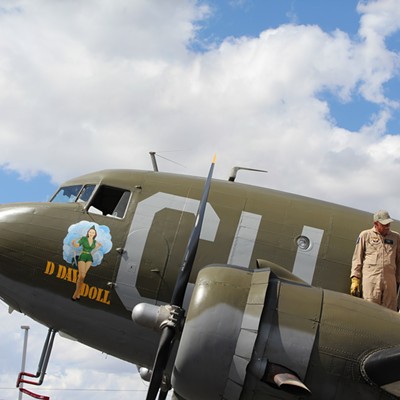"I wondered what black people did here," Wilson says of these early settlers. "What I found was a lot of them came to Tucson for a better way of life. They came with a drive to be independent by owning their own business or land."
One of those pioneers was Samuel Bostick, a native of Alabama who was in Tucson before 1870.
Bostick was involved with both Pima County and Pinal County real estate and operated a barber shop in Tucson. In the collection of the Arizona Historical Society, Wilson even discovered an 1872 photograph of Bostick standing in the doorway of a Florence, Ariz., cantina.
Wilson says he found that there were about two dozen African Americans in Tucson as early as 1864, and a total of 426 lived here and were recorded by the Census between 1860 and 1900. He has highlighted more than 50 of these people in his recently published The Black Residents of Tucson and Their Achievements, 1860-1900, A Reference Guide, available at www.
arizonablackpioneers.com for $25.
Wilson used data from the U.S. Census, the county recorder's office and other sources, and he was surprised by the amount of historic material available.
"I found more information than I thought I would," he says, "including photos, newspaper ads and cemetery headstones. I was impressed."
Wilson says he organized the material "like an encyclopedia: Here are the facts. I'm not a writer," he explains of his format.
Based on his research, Wilson thinks the early black residents of Tucson faced many of the same challenges that everyone else did. "Everybody out here had to get along," he observes. "They weren't that big on race."
But Tucson's early black citizens did have some special obstacles, including finding homes to rent.
"I don't believe they would have had a place to stay if Germans hadn't rented to them," Wilson says. "The Germans in Tucson saw a need and saw there was money to be made."
While some of Tucson's initial black residents became wealthy, Wilson estimates 90 percent of them were employed in the service industry. "They were bellhops, did laundry or were porters," he says. "They were needed."
James Anderson was one of these people. He came to Tucson before the railroad arrived in 1880 and worked as a household steward, a shoe shiner and later as a bellhop at the Santa Rita Hotel.
Anderson also purchased property in both Pima County and Pinal County. He additionally held an interest in a local mine which he bought in 1893.
Another African American who prospered in Tucson was Anna Box Neal (See "Portraits From the Past," Currents, Feb. 20, 2003). Of all the people Wilson researched, she is his favorite.
"She was a fun person," Wilson says of Neal. After she and her husband, William, began building a resort hotel in Oracle, Wilson says, "She took over the project. ... She also set up a shooting range and other events for women."
According to Wilson's research, Annie's father, Wiley Box, may have been in Tucson shortly after the Gadsden Purchase of 1854. Wilson writes of Box and his wife, Hannah, "(They) purchased some mines and did some prospecting in Arizona. Mining was a financial risky adventure to undertake."
Box's son-in-law, William Neal, was also involved with mining. But Wilson comments about him: "He started out in mining but realized there was nothing to be made from it. So he got into supplying mines."
While William and Anna Neal established a successful business in Oracle, her father met with an unfortunate fate in Tucson. In his book, Wilson includes a copy of a June 1913 Arizona Daily Star article which summarizes the tragic event.
According to the story, the 76-year-old man was apparently living in an adobe structure downtown. While lying on a cot in the building, his legs were wrapped in gasoline-soaked cloth and set afire by two men as a "practical joke." The burns Box received led to his death.
"One of those responsible," Wilson says, "was fined while the other was released. The fine was very insignificant."
Wilson has also used 1920 information to compile a map showing where the community's African-American population lived at that time.
When he first began working on his mother's family history many years ago, Wilson says, he quickly learned an important lesson about genealogical research: "Write to companies," he states simply.
Wilson says he wrote Chevron about a piece of Louisiana land his great-grandfather leased to the company. "He put his 'X' on the agreement in 1900," Wilson recalls of his ancestor.
A few months after his request was sent, Wilson says, the giant oil company responded. They provided a great deal of information about his family tree, which they had compiled because of that original agreement.
For his next project, Wilson is looking at Tucson's black population between 1910 and 1930.
"Whether I'll do it as a CD, DVD or as a book, I just don't know," he says of this future addition to local historic research.












